Read Ruler and Graduated Cylinder With Correct Significant Figures
 | Math Skills Review Meaning Figures |
There are two kinds of numbers in the globe:
- exact:
- example: In that location are exactly 12 eggs in a dozen.
- example: Most people have exactly 10 fingers and 10 toes.
- inexact numbers:
- example: any measurement.
If I quickly measure the width of a slice of notebook paper, I might become 220 mm (2 significant figures). If I am more than precise, I might go 216 mm (iii significant figures). An even more precise measurement would exist 215.6 mm (4 significant figures).
- example: any measurement.
PRECISION VERSUS ACCURACY
Accurateness refers to how closely a measured value agrees with the correct value.
Precision refers to how closely individual measurements agree with each other.
In any measurement, the number of significant figures is critical. The number of meaning figures is the number of digits believed to be correct by the person doing the measuring. It includes one estimated digit. So, does the concept of significant figures deal with precision or accuracy? I'll answer this question after you peruse the next case.
Let's look at an example where significant figures is important: measuring volume in the laboratory. This tin be done in many ways: using
- a beaker with volumes marked on the side,
- a graduated cylinder, or
- a buret.
A rule of thumb: read the volume to 1/ten or 0.1 of the smallest division. (This rule applies to any measurement.) This means that the error in reading (called the reading error) is  ane/ten or 0.i of the smallest division on the glassware. If you are less sure of yourself, you tin read to one/5 or 0.2 of the smallest partitioning.
ane/ten or 0.i of the smallest division on the glassware. If you are less sure of yourself, you tin read to one/5 or 0.2 of the smallest partitioning.
| Chalice | 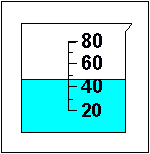 | The smallest division is x mL, then we can read the volume to  one/10 of 10 mL or one/10 of 10 mL or  1 mL. The book nosotros read from the beaker has a reading error of 1 mL. The book nosotros read from the beaker has a reading error of  1 mL. 1 mL.The volume in this beaker is 47 So, How many pregnant figures does our volume of 47 |
| Graduated Cylinder | 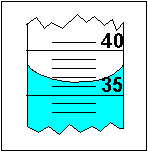 Look in the textbook for a picture show of a graduated cylinder. | Outset, note that the surface of the liquid is curved. This is called the meniscus. This miracle is caused by the fact that water molecules are more attracted to glass than to each other (adhesive forces are stronger than cohesive forces). When we read the volume, we read information technology at the Bottom of the meniscus. The smallest partitioning of this graduated cylinder is 1 mL. Therefore, our reading error will exist How many meaning figures does our respond accept? 3! The "3" and the "six" we know for sure and the "five" we had to estimate a little. |
| Buret | 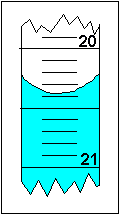 Look in the textbook for a motion-picture show of a buret. Note that the numbers go bigger as you go downwardly the buret. This is different from the beaker or the graduated cylinder. This is considering the liquid leaves the buret at the bottom. | The smallest sectionalization in this buret is 0.i mL. Therefore, our reading error is  0.01 mL. A skillful volume reading is 20.38 0.01 mL. A skillful volume reading is 20.38  0.01 mL. An every bit precise respond would be xx.39 mL or xx.37 mL. 0.01 mL. An every bit precise respond would be xx.39 mL or xx.37 mL. How many significant figures does our answer have? 4! The "2", "0", and "3" we definitely know and the "viii" we had to approximate. |
Conclusion: The number of significant figures is directly linked to a measurement. If a person needed simply a crude gauge of book, the beaker volume is satisfactory (ii meaning figures), otherwise one should use the graduated cylinder (iii pregnant figures) or better however, the buret (4 significant figures).
So, does the concept of significant figures bargain with precision or accurateness? Hopefully, y'all tin can see that information technology really deals with precision only. Consider measuring the length of a metallic rod several times with a ruler. Yous will get essentially the same measurement over and over once again with a small reading error equal to near one/10 of the smallest sectionalisation on the ruler. You lot have adamant the length with high precision. Notwithstanding, you don't know if the ruler was accurate to begin with. Possibly it was a plastic ruler left in the hot Texas sun and was stretched. Yous don't know the accuracy of your measuring device unless yous calibrate it, i.e. compare it confronting a ruler you knew was accurate. Note: in the laboratory, a good belittling chemist e'er calibrates her volumetric glassware earlier using information technology by weighing a known book of liquid dispensed from the glassware. By dividing the mass of the liquid by its density, she can determine the actual volume and hence the accurateness of the glassware.
Rules for Working with Significant Figures:
- Leading zeros are never meaning.
Imbedded zeros are always significant.
Trailing zeros are significant only if the decimal point is specified.
Hint: Change the number to scientific notation. It is easier to see. - Add-on or Subtraction:
The final digit retained is set past the first hundred-to-one digit. - Multiplication or Sectionalisation:
The reply contains no more significant figures than the to the lowest degree accurately known number.
EXAMPLES:
| Example | Number of Significant Figures | Scientific Notation | ||
| 0.00682 | 3 | 6.82 x x -three | Leading zeros are non significant. | |
| 1.072 | iv | 1.072 (x 100) | Imbedded zeros are always meaning. | |
| 300 | 1 | iii x 102 | Trailing zeros are meaning only if the decimal point is specified. | |
| 300. | three | 3.00 x ten2 | ||
| 300.0 | iv | 3.000 10 102 |
EXAMPLES
| Add-on | 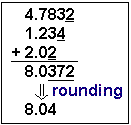 | Even though your calculator gives you the reply 8.0372, you must round off to 8.04. Your answer must simply contain one doubtful number. Note that the doubtful digits are underlined. |
| Subtraction | 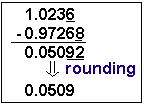 | Subtraction is interesting when concerned with significant figures. Fifty-fifty though both numbers involved in the subtraction have 5 significant figures, the answer just has 3 significant figures when rounded correctly. Recall, the answer must just have 1 doubtful digit. |
| Multiplication | 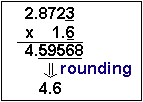 | The answer must be rounded off to 2 pregnant figures, since 1.half-dozen only has ii meaning figures. |
| Division | 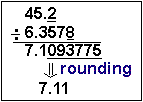 | The answer must exist rounded off to three significant figures, since 45.ii has only 3 pregnant figures. |
Notes on Rounding
- When rounding off numbers to a certain number of significant figures, do so to the nearest value.
- example: Round to 3 significant figures: 2.3467 10 10four (Respond: 2.35 x 104)
- example: Round to two significant figures: 1.612 ten 103 (Answer: ane.6 10 103)
- What happens if there is a 5? At that place is an capricious rule:
- If the number before the 5 is odd, round up.
- If the number before the 5 is even, allow information technology be.
The justification for this is that in the course of a serial of many calculations, whatsoever rounding errors will be averaged out. - example: Circular to 2 pregnant figures: two.35 x tenii (Reply: 2.4 x x2)
- example: Circular to two significant figures: 2.45 x x2 (Answer: two.4 x 10ii)
- Of course, if we circular to 2 pregnant figures: 2.451 10 102, the respond is definitely 2.5 x 102 since ii.451 x 10two is closer to two.5 x 10two than ii.4 x tentwo.
QUIZ:
| Question 1 | Give the right number of pregnant figures for 4500, 4500., 0.0032, 0.04050 |
| Question 2 | Requite the reply to the correct number of significant figures: 4503 + 34.90 + 550 = ? |
| Question 3 | Give the answer to the correct number of significant figures: 1.367 - 1.34 = ? |
| Question four | Requite the answer to the right number of pregnant figures: (one.iii x 103)(5.724 x 104) = ? |
| Question v | Give the answer to the correct number of meaning figures: (6305)/(0.010) = ? |
Answers: (i) ii, 4, 2, 4 (ii) 5090 (3 significant figures - circular to the tens place - set by 550) (3) 0.03 (1 pregnant figure - round to hundredths identify) (4) 7.4 x x7 (2 meaning figures - set by 1.3 x 103) (5) half dozen.3 10 ten5 (2 meaning figures - fix by 0.010)
Selection your next topic:
Source: https://www.chem.tamu.edu/class/fyp/mathrev/mr-sigfg.html
0 Response to "Read Ruler and Graduated Cylinder With Correct Significant Figures"
Post a Comment